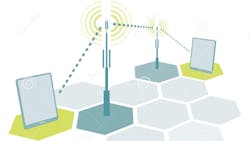Researchers Demonstrate SDR-Based Wireless Tomography
As the Internet of Things (IoT) takes root, RF and wireless technologies are increasingly being used to enable sensing platforms. Taking this concept to the next step, RF sensing and tomography techniques were used to demonstrate an RF remote sensing concept by the research team of Jason Bonior, Zhen Hu, Terry N. Guo, Robert C. Qiu, James P. Browning, and Michael C. Wicks. With funding from the National Science Foundation, these researchers created images of single- and multi-target scenarios by employing automatic data-acquisition technology, an RF anechoic chamber, a software-defined radio (SDR), and phase reconstruction.
The experimental system implemented by the scientists compared the results of a vector network analyzer (VNA) and universal serial radio peripheral (USRP)-based software-defined-radio (SDR) tomography device. Whereas the VNA is capable of measuring the actual scattering field, the SDR could only produce amplitude information without phase. Interestingly, the semi-definite relaxation method did provide a strong approximation of the amplitude and phase for these measurements. The measurements correlated strongly with the measured scattering field.
After confirming the viability of the phase-reconstructing methods, the researchers compared the VNA and SDR data with the magnitude take of the VNA data. Here, the amplitude-only information is fed into the processing methods.
With the phase-reconstructed data, it is possible to estimate both the dielectric constant of the target and its position. Unfortunately, the method used produced a consistent error in the target’s position. Despite this issue, the experimental data succeeded in proving that RF tomography can be performed with an SDR along with phase-reconstruction techniques. It should be noted that this system used commercial-off-the-shelf (COTS) communications devices. Thus, remote imaging systems using the advanced techniques proven in this research could enable cost-effective radio imaging in the future.
See “Software-Defined-Radio-Based Wireless Tomography: Experimental Demonstration and Verification,” IEEE Geoscience and Remote Sensing Letters, Jan. 2015, p. 175-179.
About the Author
Jean-Jacques DeLisle
Jean-Jacques graduated from the Rochester Institute of Technology, where he completed his Master of Science in Electrical Engineering. In his studies, Jean-Jacques focused on Control Systems Design, Mixed-Signal IC Design, and RF Design. His research focus was in smart-sensor platform design for RF connector applications for the telecommunications industry. During his research, Jean-Jacques developed a passion for the field of RF/microwaves and expanded his knowledge by doing R&D for the telecommunications industry.
